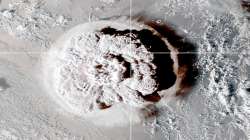The massive shockwaves due to the eruption of Hunga-Tonga-Hunga-Ha'apai in Tonga were also felt across India, meteorologists said on Monday.
"Every weather station across India recorded the spike. It was expected and it was noticed," said D.S. Pai, who heads India Meteorological Department's (IMD) climate research and services in Pune.
For instance, IMD Goa said between 8.45 p.m. and 9 p.m. on January 15, the automatic weather station (AWS) at Panaji recorded a rise in pressure by 1.3 milli bars (written as 1.3hpa), supposedly because of the shockwaves .
IMD Goa tweeted a barometer graph that showed a clear spike along the curve that regularly showed the regular diurnal recordings in wave form.
In fact, almost 12 hours after that, i.e., on Sunday morning, an amateur weather enthusiast from Goa, Atul Naik, posted on Twitter another graph that showed the second peak too.
The violent volcanic eruption on January 14 continued for over 12 hours and it again erupted for eight minutes the following day sending massive plumes of ash into the sky.
Tsunami waves hit Tonga on the evening of January 15.
The tsunami followed a series of violent eruptions from submarine volcano Hunga Tonga Hunga Ha'apai, 65 km north of the country's main island Tongatapu.
Tsunami warnings were issued in Australia, New Zealand, Japan and the US.
Also Read | United Nations ready to assist Tonga after volcano eruption, tsunami
Also Read | Soon after Tsunami warning for US West Coast, undersea volcano erupts near Tonga
Latest India News
